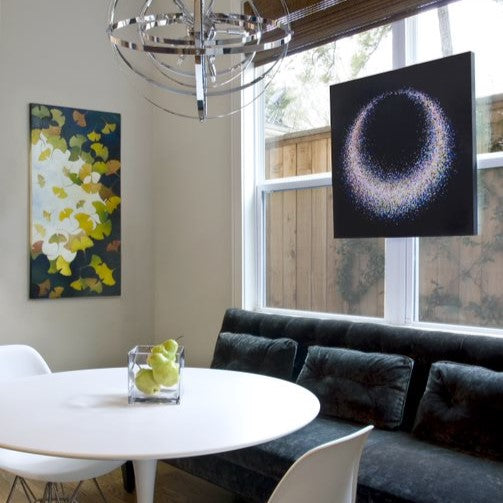How to Hang Art from the Ceiling or High on a Wall



When displaying art, thinking outside the box can have a stunning and unexpected result. Hanging art from the ceiling or high on a wall lets you move beyond conventional design while adding sophistication and interest to your wall space.
Whether you're a renter steering from wall damage or a homeowner wanting to elevate your room, proper care and placement of your art are key to making an impact.
In this guide, we'll share tips, tools, and techniques for creating a secure and beautiful art display. No matter your space or skill level, we'll help you make your favorite painting a focal point in your dream home.
Why Hang Art From The Ceiling Or High On A Wall
Before anything else, let's check out some of the benefits of using this unique approach to hanging artwork.
- Highlights Vertical Spaces: In rooms with tall walls or high ceilings, hanging artwork naturally draws the eye upward and makes the area feel more expansive.
- Protect Your Walls: By using hooks, rails, or beams, mounting your artwork from the ceiling minimizes wall damage.
- Create A Focal Point: When placed over furniture, on blank walls, or suspended in the middle of a room, high-mounted or ceiling-mounted art catches attention and anchors the space.
- Add Visual Balance: Putting up a large piece of art or hanging multiple pieces keeps rooms with tall walls or high ceilings from feeling empty or top-heavy.
Basic Rule Of Hanging Artwork
Art is an essential aspect of home decor that can enhance the overall ambiance and aesthetic of a room. To hang art, consider the size and height of the room, the color of the walls, and the placement of furniture. The wall and room's decor should go well with the art, and vice versa. Think about the art you want to display and the style you want to achieve. Whether it's a modern piece or a classic painting, the artwork should anchor the room's theme and palette. By thoughtfully considering these aspects, you are a step closer to elevating your home.

Tools And Materials You Need
In hanging artwork, it is essential to gather the right tools and materials to minimize mistakes and have a safe installation process. Here are some things you will need to get you started:
- Hooks or Ceiling Anchors – For attaching art securely to walls or ceilings.
- Adhesive Hooks or Strips – A drill-free option for lightweight artwork. Perfect for renters and lighter art.
- Wire or Fishing Line – Durable options for suspending artwork.
- Measuring Tape – To ensure accurate placement.
- Step Ladder – For safely reaching high areas.
- Pencil – For marking measurement points.
- Spirit Level – To keep everything straight (optional but handy).
- Hand drill – For securing hooks onto walls.
- Painter's Tape and Brown Paper –To map out and test art placement.
- D-Rings – For added stability.
Step-By-Step Guide
Using a hanging system is a popular and creative solution for hanging art from the ceiling or high on a wall. This typically involves a rail mechanism installed near the top of the wall, from which art is suspended using wires or cables. Not only do they allow for flexibility in arranging and rearranging artwork without causing additional wall damage, but they also offer a clean, gallery-inspired aesthetic. And, if you have an unconventional wall space, this method is a sure way to go.
Step 1: Measure
Proportionate your art to the size and height of your room. The higher the ceiling, the larger and the bigger the quantity of artwork should be.
The basic rule is to position the center point of your artwork or collection around 57-60 inches from the floor. This standard eye-level measurement ensures a balanced and aesthetically pleasing look when you hang pictures, whether it's on a gallery wall, artwork above furniture, or in personal spaces. Adjustments may be needed depending on room architecture and furniture arrangements.
If your ceiling is 9 feet or higher, you can slightly raise your artwork to maintain visual balance. Just make sure the center point of your art is still within the average eye level.

Step 2: Choose The Artwork
After measuring your space, consider the style of the artwork you want to hang. Choose a minimalist design if you're aiming for a modern look. Go for classical painting if you want a more traditional aesthetic. You can also get creative and make your own rules. Just keep in mind that the art should go well with the room and furniture.
If you are hanging art above a sofa or console table, the width of your art piece should be about two-thirds the length of your furniture piece and 8-10 inches above it.

Step 3: Layout and Mark With Templates
To avoid mistakes, plan your layout carefully before drilling holes. You can follow these steps:
- Trace and cut the measurements of your art pieces or picture frames from brown paper.
- Hang the cutouts on the wall using painter's tape.
- Step back and assess the arrangement. Consider the spacing, symmetry, and visual balance. And don't forget the eye level rule.
- Adjust and finalize the arrangement.
Step 4: Install Hanging Systems
Investing in heavy-duty hanging systems when installing your artwork is essential for safety and stability.
- Adhesive hooks and strips are perfect for lightweight artwork.
- Use wall hooks and ceiling anchors for moderately heavy artwork.
- Depending on the aesthetic you're after, old-fashioned picture rails or modern picture hanging systems are great for a suspended art display.
- If the artwork is quite heavy and delicate, it is best to consult an interior designer or professional installer.
Step 5: Hang Artwork
Hang your art safely and securely using these steps:
- Attach d-rings or picture wires at the back of the artwork.
- Always ensure the hanging wires or cables are taut and positioned to prevent pieces from tilting or shifting.
- Carefully hang the artwork on hooks and cables. Use a spirit level to keep everything aligned.
- Step back and access. Adjust if needed.
Step 6: Add Lighting
Proper lighting enhances the visibility and impact of your art display. If you want a more museum-quality finish, use the following:
- Track lighting
- Ceiling-mounted accent lights
- Picture lights
- Wall washers

Methods For Hanging Art From The Ceiling
Direct Connection To The Ceiling
Suppose your walls are altogether unconducive for hanging artwork. In that case, Martha Stewart advises that you can drive hooks directly into the ceiling. You can use ropes, leather, or chains to hang artwork and match the aesthetic of your room - whether modern, rustic, or industrial.
Modern Picture Hanging Systems
You don't have to own an upscale Manhattan art gallery to showcase your artwork in a sophisticated manner. There are affordable products that can give you a professional gallery setup.
- Mounted Rail: This is ideal if you don't have an existing railing or crown molding. The system is typically installed where the wall meets the ceiling but can be positioned lower to align with sightlines.
- Hooks and Cables: Use adjustable cables with slidable hooks attached directly to a rail for easy art replacement and adjustment.
Old Fashioned Picture Rails
Suspended art from picture rails harkens to timeless elegance, which makes sense given its roots in 19th-century homes. If you have picture rails, this method is perfect to add classic charm to your own home. For those without, HGTV has a straightforward guide to hanging pictures while achieving the same effect.
This approach typically involves using:
- Heavy-duty cord or wire
- Decorative wooden rails and friezes that blend with crown molding
- Brass and metal rods
Setup Ideas
Suspended Gallery Wall
Great for foyers, staircases, or rooms with high ceilings. Combine different art and frame sizes to add a dynamic feel while maintaining visual balance. We recommend using uniform chains or ropes for a more cohesive look.
Floating Artwork
Perfect for minimalist and contemporary spaces. Hang lightweight and smaller pieces using cables or transparent fishing lines to create a "floating" effect.
Rotating Art Display
This is a great setup for homeowners or art collectors who like variety. Use ceiling hooks or rail systems to easily swap artwork for different seasons or occasions.
Single Statement Piece
Ideal for an open-space concept. Hang one large, bold piece of art to create a focal point in the room. Use stronger materials to secure the artwork, and make sure to hang it at eye level.
Suspended Art Installation
Introduce texture, dimension, and movement to your space by suspending lightweight sculptures or art pieces. This setup is ideal for bohemian, eclectic, or contemporary interiors.

Common Design Mistakes
1. Hanging Art At The Wrong Height
Implement the eye-level rule in hanging artwork. If hung too high or too low, looking at the artwork can be uncomfortable and disrupt the room's flow.
2. Poor Layout Planning
Make sure you test placement before hanging pictures or art pieces. Pay attention to symmetry and spacing to avoid design mistakes.
3. Ignoring Wall Proportions
Scale is key. Always choose art that is appropriate to the wall size and ceiling height for a balanced look.
4. Using Inadequate Hardware
Use professional-rated hooks, anchors, and cables to avoid damaging your art and your home.
Final Thoughts
If you're exploring new and interesting ways to display your artwork, we hope these suggestions have been useful. Whether you're showcasing a single large piece, creating a gallery wall, or suspending an art installation, the key lies in thoughtful planning and the right tools.
If you're in the market for additional original artwork, check out UGallery. Let the inner interior designer in you shine, and happy decorating!





